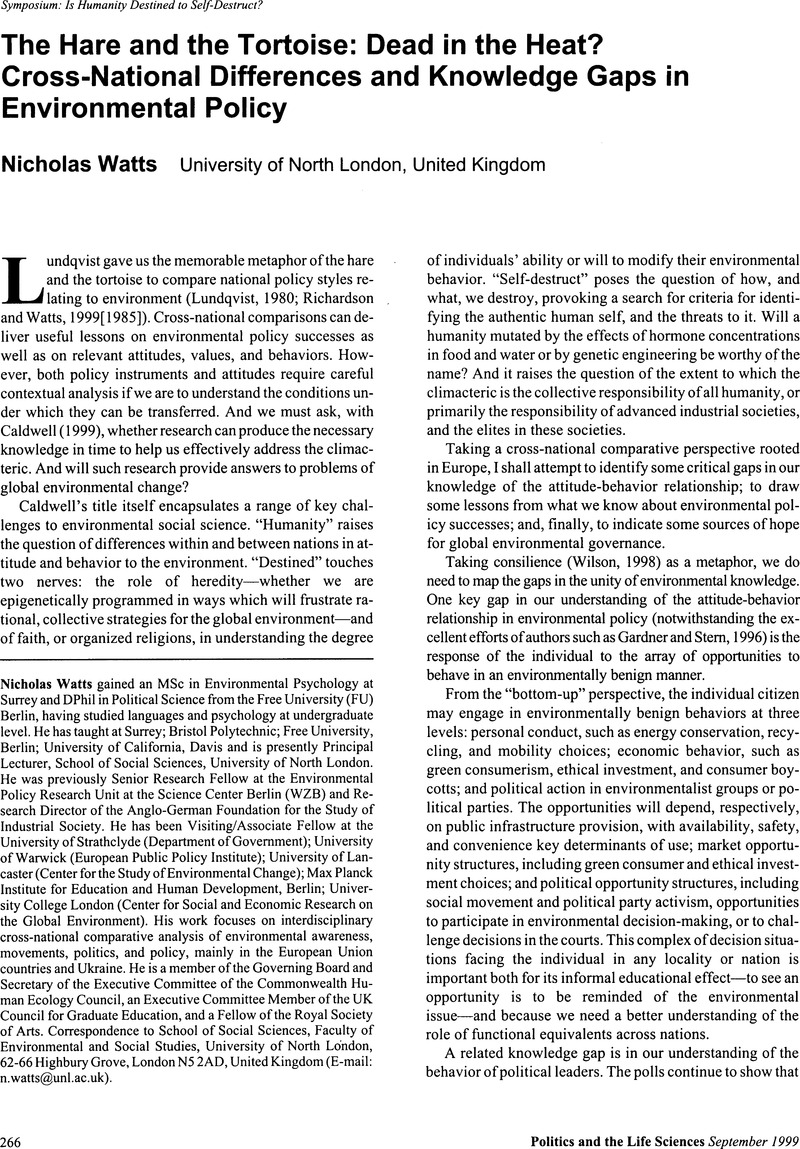No CrossRef data available.
Article contents
The Hare and the Tortoise: Dead in the Heat? Cross-National Differences and Knowledge Gaps in Environmental Policy
Published online by Cambridge University Press: 17 May 2016
Abstract
An abstract is not available for this content so a preview has been provided. Please use the Get access link above for information on how to access this content.

- Type
- Symposium: Humanity and Self-Destruction
- Information
- Copyright
- Copyright © Association for Politics and the Life Sciences
References
Bartlett, R.Y. and Kurian, P.A. (1999). “The Theory of Environmental Impact Assessment: Implicit Models of Policy-Making.” Policy and Politics 27(4): 415–433.Google Scholar
Caldwell, L.K. (1990). Between Two Worlds: Science, the Environmental Movement, and Policy Choice. Cambridge: Cambridge University Press.Google Scholar
Caldwell, L.K. (1999). “Is Humanity Destined to Self-Destruct?” Politics and the Life Sciences 18: 3–14.Google Scholar
Gardner, G.T. and Stern, P.C. (1996). Environmental Problems and Human Behaviour. Boston, MA/London: Allyn and Bacon.Google Scholar
Giddens, A. (1998). The Third Way: The Renewal of Social Democracy. Cambridge: Polity.Google Scholar
Habermas, J. (1996). Between Facts and Norms: Contributions to a Discourse Theory of Law and Democracy. Cambridge: Polity.Google Scholar
Hajer, M.A. (1995). The Politics of Environmental Discourse. Ecological Modernization and the Policy Process. Oxford: Oxford University Press.Google Scholar
Inglehart, R. (1997). Modernization and Postmodernization: Cultural, Economic, and Political Change in 43 Societies. Princeton, NJ: Princeton University Press.Google Scholar
Jänicke, M. and Weidner, H., eds. (1995). Successful Environmental Policy: A Critical Evaluation of 24 Cases. Berlin: Edition Sigma.Google Scholar
Kingdon, J.W. (1984). Agendas, Alternatives and Public Policies. Boston: Little, Brown.Google Scholar
Lundqvist, L.J. (1980). The Hare and the Tortoise. Clean Air Policies in the United States and Sweden. Ann Arbor, Ml: University of Michigan.Google Scholar
Mez, L. and Weidner, H., eds. (1997). Umweltpolitik und Staatsversagen. Perspektiven und Grenzen der Umweltpolitikanalyse. (Environmental Policy and State Failure. Perspectives and Limits to Environmental Policy.) Festschrift für Martin Jänicke zum 60. Geburtstag. Berlin: Edition Sigma.Google Scholar
Richardson, J.J. and Watts, N.S.J. ([1985] 1999). “National Policy Styles and the Environment. Britain and West Germany Compared.” In Rüdig, W. (ed.), Environmental Policy. London: Edward Arnold.Google Scholar
Watts, N.S.J. (1988). “Environmental Complaint and Concern in the European Community.” In Canter, D., Krampen, M., and Stea, D. (eds.), Environmental Policy, Assessment and Communication. Aldershot, UK: Avebury.Google Scholar


